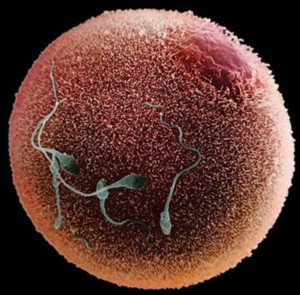Gene Mapping
Genes are just patterns of chemical molecules that are held within the replicating DNA mechanism. The way they are encoded onto DNA can be likened to any other mechanism for copying and recording data: a DVD or even a vinyl record or the memory in this computer. As a result they can be altered or damaged from time to time and some of these variations are successfully copied into subsequent offspring. If they are particularly advantageous to survival and reproduction these changes, or mutations, rapidly spread throughout the species, so that over tens of thousands of years, individuals successful in one environmental niche are so different from those successful in another that a new species has formed (followed by a new genus, family, order, and so on).
This process of periodic differentiation has been likened to the branching of a tree but because of the activity of bacteria and viruses and residual DNA that may be reactivated as well as limited cross-species reproduction (for example later Humans and Neanderthal) it is no longer believed to be quite that simple.
DNA encodes the instructions for creating each cellular colony, defining each species, and each individual within a species. DNA changes over time in such away that each change is a development on previous generations. So it is possible to trace DNA ancestry back through generations of a particular species over time. For example, DNA studies are increasingly shedding light on the questions around human origins.
Most animals, including humans, carry two types of DNA. Our main genome is carried by the chromosomes in the nucleus of each of our cells. This comes from both our parents. The secondary genome, mtDNA, is carried by bacteria-like organelles within each of our cells, that convert sugars for cell energy, called mitochondria. These are all cloned (reproduced by asexual division) from the mitochondria that were within the original egg cell provided by our mother.
Cells may contain from one mitochondrion to several thousand mitochondria depending on species and cell differentiation. As a result this is the predominant DNA found in a cellular sample.
So our mtDNA comes only from our mother; in turn from her mother; and so on and mtDNA allows us to map the female ancestral line. This original egg cell was fertilised by a sperm from our father (sperm do not contribute their mitochondria). Once fertilised, the egg cell then divided repeatedly, differentiating in accordance with the coding instructions in our DNA, into the many cells that form the cellular colony that became 'us'.
Males are differentiated from females by a Y chromosome in place of one X. So sons can only inherit this from their father (like their family name in our culture) and periodic mutations in the DNA of the Y chromosome allow the (actual) male ancestral line to be traced back.
As a result of this work we now know that humans on the planet are all descended from a single group that left Africa less than 70 thousand years ago.
Recent DNA analysis shows that early humans sometimes interbred with the Neanderthal; a separate hominid subspecies that left Africa much earlier and settled in the Middle East and Europe over quarter of a million years ago.
It's amazing to think that we have only understood it within my lifetime. Now the ancient view that people grow from a seed, provided by their father, and gain the spark of life at 'conception' from a god is totally debunked. So throw away all those ancient texts.

